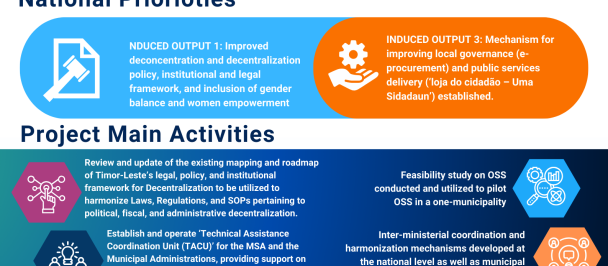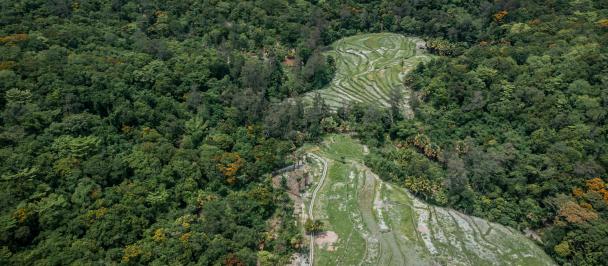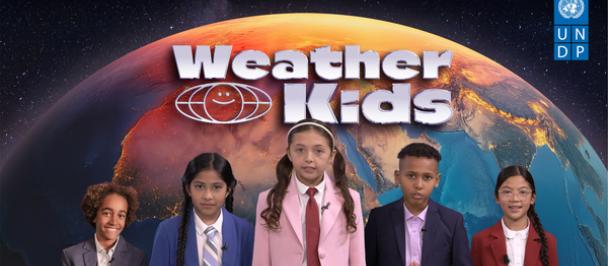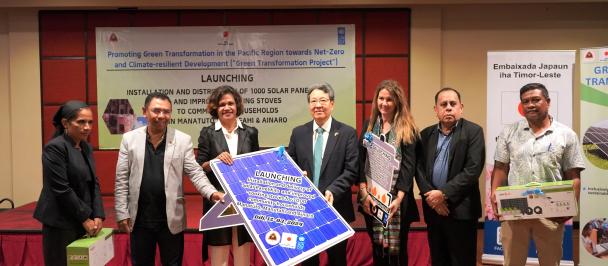Timor-Leste is at a critical juncture: the blue economy brings new opportunities. Identifying new and innovative financing options is critical
New Blue Economy Opportunities For Timor-Leste
March 10, 2022
Timor-Leste Beautiful View mountain and beach
Timor-Leste is at a critical juncture: the blue economy brings new opportunities. Identifying new and innovative financing options is critical
The recent UN Climate Change Conference in Glasgow (COP26) underscored the urgency of the global transition away from fossil fuels towards greener models of economic growth that bring people and planet back into balance. The Glasgow Climate Pact commits countries around the world to accelerate emissions reductions and phase out fossil fuel subsidies. Timor-Leste is not a large emitter of green house gasses. However, like all nations, it needs to consider how best to reduce its dependence on fossil fuels, especially as a source of income, and explore how the country can create new opportunities for sustainable employment and decent work.
Timor-Leste is at a critical development juncture. The country has been heavily dependent on oil and gas since it regained its independence in 2002, contributing around 90% of the country’s revenues in recent years. However revenue from oil will start to decline over the next decade. At the same time, poverty levels remain high at almost 40% of the population. This has been made worse by the COVID-19 pandemic. Timor-Leste must therefore prioritise diversification of the economy and sources of income if its development ambitions to become an upper-middle-income country are to be met and the Sustainable Development Goals (SDGs) are to be achieved by 2030. With Presidential elections imminent and parliamentary elections likely to follow, political leaders in the country will need to make important choices as to how to address the economic challenges and opportunities the country faces over the next period.
A COMPREHENSIVE LOOK AT HOW FINANCE CAN BE MOBILISED AND USED MORE STRATEGICALLY
In 2019, the Timorese government prepared its first Voluntary National Review (VNR) of the SDGs. One of the conclusions was that while Timor-Leste has a clear vision for achieving the SDGs as articulated in its Strategic Development Plan (2011-2030), what was missing was a plan for diversifying the economy and creating sustainable jobs for citizens, especially for youth that constitute 74% of the population.
Against this backdrop, the UN Joint SDG Fund and UNDP have extended technical and financial support to Timor-Leste to develop its first “Blue Economy Financing Roadmap”. The Roadmap is a strategic document that explores opportunities to leverage finance at-scale for sustainable “blue growth” in Timor-Leste. Blue growth is about the sustainable use of ocean resources for economic growth and improved livelihoods while preserving the health of ocean ecosystems.
The Roadmap is part of a broader piece of work supported by the UN system, to assist Timor-Leste to develop an Integrated Financing Framework (INFF) and help it meet the SDGs. An INFF helps governments to identify and unlock new sources of public and private finance, as well as use these resources more strategically. This work has also included a collaboration between the Ministry of Finance and IOM on ways to attract greater investment from the Timorese diaspora, as well as exploring ways to raise revenue from taxation on tobacco and alcohol products led by WHO. The INFF is also closely aligned with and contributes to the government’s ongoing Public Finance Management (PFM) reforms and supports other strategic national development plans.
LEVERAGING FINANCE AT SCALE FOR SUSTAINABLE ‘BLUE GROWTH’ IN TIMOR-LESTE
Timor-Leste is one of several Small Island Developing States (SIDS), that is increasingly recognising the promising sustainable development opportunities represented by the blue economy. Some are also piloting new and innovative approaches to financing key blue economy interventions. These include the Seychelles with its issuance of blue bonds and a debt-for-nature swap focused on sustainable fisheries in 2018. Fiji also launched a green bond in 2017, to be followed by a blue bond in 2022.
Timor-Leste’s Financing Roadmap explores the role that the blue economy can play in accelerating sustainable economic development across the four key pillars of the country’s Strategic Development Plan: social capital; infrastructure development; economic development; and institutional frameworks. It focuses in particular on the ways in which both domestic and external financial resources can be leveraged in innovative and strategic ways to support the blue economy and the transition to a post-oil economy. It is a process that must be inclusive of all stakeholders and citizens.
At the COP-26 climate change conference, Timor-Leste’s delegation, headed by the Minister of Foreign Affairs and Cooperation, Adaljiza Albertina Xavier Reis Magno, emphasised the significant, underexplored opportunities that the blue economy could potentially offer as a source of sustainable income and livelihoods. The Secretary of State for the Environment, Demétrio do Amaral de Carvalho, summarised it well when he said that: “It is self-evident that Timor-Leste’s post-oil future depends solely on the health and abundance of its surrounding seas and their ecosystems. As we move away from a dependence on oil, decision-makers, the private sector and environmental organisations, will need to work together to build sustainable ocean economy ventures. The coastal communities of Timor-Leste, who are among the most vulnerable to multi-dimensional poverty and deprivation, need employment and livelihoods opportunities that are sustainable. Initiatives such as mangrove rehabilitation, seagrass planting and combating land-based pollution can bring dual dividends in terms of protecting ocean ecosystems and shorelines while generating income.”
TRANSFORMING AND DIVERSIFYING THE ECONOMY
The Roadmap and the recently approved national Climate Change Policy highlight the potential to invest in a range of sectors including tourism, which is currently very small, and in fisheries, as well as various types of aquaculture including tilapia, mud crabs, seaweed and oyster farming. Many of these sectors are still in the early stages or exist only at subsistence level. These recommendations are aligned with a paper published in 2020 by the International Growth Centre on the ‘Drivers of Growth and Sectoral Transformation’. This discussed policy priorities to help Timor-Leste realise the path to middle-income status, focusing on fisheries, agriculture, and tourism as key sectors for economic transformation and analysing the role of infrastructure investment, financing frameworks, and digital innovation.
Marine renewable energy, green port development and sustainable marine transportation are also major blue economy investment opportunities in Timor-Leste – with potential to be truly transformational. A new port is under development near Dili, financed through Timor-Leste’s first public-private-partnership (PPP), and there is a stronger recognition by the authorities that sustained and targeted public and private investment is needed in port infrastructure and marine transportation, especially in Timor-Leste’s secondary ports.
It is clear that a step-change in both public and private investments will be required to fully realise the blue economic opportunities in the country. The Roadmap suggests ways in which key sources of domestic and international finance can be leveraged more strategically to accelerate blue growth in Timor-Leste.
LEVERAGING THE PETROLEUM FUND
The Roadmap looks at how Timor-Leste’s Petroleum Fund could be utilised to create an institutional mechanism to support long-term sustainable blue and green growth. It recommends the Petroleum Fund be used to capitalise a new Blue Economy Financing Facility. It advises that the facility should not be established as a small pilot fund, but rather as a larger mechanism which is able to offer technical assistance and capacity-building support on the blue economy, as well as a mix of financial instruments to support high-value, high yielding blue economy strategic projects and enterprises, including through the use of incentives, grants, concessional loans and guarantees. The Roadmap also notes that development partners can play an important role to support the facility with both technical assistance and concessional financing, especially in its early days.
The Roadmap also explores the potential to leverage new and innovative debt financing instruments like blue bonds. Timor-Leste’s favourable debt position means it may have the scope to explore a blue bond issuance at some point over the next few years. As a low-income country however, any new debt issuance needs to be carefully managed and the Roadmap points to the key role that the Central Bank and development partners can play, particularly multilateral development banks, which can provide technical assistance (in project identification and targeted investor outreach) as well as direct financing support (for example to de-risk these bonds as a way of attracting additional investment from a range of sources). Other innovative sources of finance, such as blue carbon markets, which are set to rise exponentially over the next decade, also represents a potential opportunity for Timor-Leste.
DEVELOPMENT AID AS TRANSFORMATIVE SUPPORT
Official Development Assistance (ODA) has been a valuable resource to Timor-Leste since restoration of independence and development partners have funded a range of programmes linked to the blue economy. These include aquaculture, mangrove restoration, development of agricultural and other cooperatives, tourism development including scuba-diving, as well as professional training to seafarers. But it is also clear that the level of ODA in Timor-Leste has been decelining over the past decade. So there is a need to look at different ways of using public aid monies, including blended finance to create new opportunities for sustainable jobs and growth.
TYING DOWN THE NATIONAL BUDGET TO SDGS
In parallel, Timor-Leste has carried out its first ever Climate Public Expenditure and Institutional Review (CPEIR), launched in January 2022 by the Minister of Finance, Rui Augusto Gomes. The CPEIR represents an important step to ensure more public finance is responsive to climate change. The analysis shows that in 2018, about 5% of GDP was spent on ‘high climate relevant’ programmes but this dropped to 2.3% in 2020. This exercise is therefore providing valuable insights into how public finance needs to integrate climate change more systematically, including through a focus on the blue economy and blue growth opportunities.
NEXT STEPS ON FINANCING BLUE GROWTH
Looking forward, the Roadmap recommends that development partners could support Timor-Leste to develop a blue economy investment plan as a tool to identify those inter-linked and transformative investments that will underpin sustainable blue growth over the next decade – and beyond. The investment plan needs to be fully costed, and donor resources should be anchored around specific investment priorities in different regions/municipalities. The Roadmap also highlights opportunities for Timor-Leste’s sizeable diaspora to be involved and contribute knowledge, skills and resources to this process.
Timor-Leste is at the beginning of a new sustainable development chapter – one which must be carefully managed to ensure a just and equitable transition that includes and benefits all Timorese people including women, girls, youth, elderly, and persons with disabilities. It is a path the government of Timor-Leste is firmly committed to.
The UN’s support for this work aims to inform a national dialogue on future development pathways for the country, and explore a range of different financing flows that can underpin economic transformation. The government has decided to proactively explore blue growth pathways and is keen to collaborate with other small island states and neighbouring countries. The UN is proud to be supporting the country in this journey, which can accelerate progress towards the SDGs.
By: Tuya Altangerel, Resident Representative, UNDP
Gail Hurley, International Consultant on Blue Economy Finance
Roy Trivedy, UN Timor-Leste Resident Coordinator

 Locations
Locations



